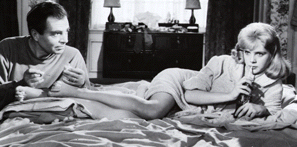
MISE-EN-SCENE
Mise-en-scène is a French term and originates in the theater. It means, literally, "put in the scene." For film, it has a broader meaning, and refers to almost everything that goes into the composition of the shot, including the composition itself: framing, movement of the camera and characters, lighting, set design and gen eral visual environment, even sound as it helps elaborate the composition. Mise-en-scène can be defined as the articulation of cinematic space, and it is precisely space that it is about. Cutting is about time; the shot is about what occurs in a defined area of space, bordered by the frame of the movie screen and determined by what the camera has been made to record. That space, the mise-en-scène, can be unique, closed off by the frame, or open, providing the illusion of more space around it. In Travelling Players (1975), a film by the Greek director Theo Angelopoulos, a group of people move into the past by taking a long walk down a street in one shot; time moves backward as they walk. There is a sequence in the film Grand Illusion (1937) by the director (and son of the Impressionist painter) Jean Renoir in which a group of World War I POWs receive a carton of gifts. Among the gifts is, unaccountably, some women s clothing. One of the soldiers puts the clothing on, and the rest stare at him in stunned silence. Renoir creates their response by gently, slowly, panning across the men staring. The movement yields up the space the men inhabit, suggests that it extends beyond the frame, and delicately emphasizes their confused sexual response to this sudden appearance of a man in woman s clothes. Had Renoir cut from face to face, the effect would have been quite different, suggesting the isolation of one man and his emotional response from the next person in the group. If he had offered only a wide shot of all the men together, their individual expressions would have been lost. The pan joins individual to group, making the revelation of space not only physical but emotional and communal, and the response more generally and genuinely human. It allows us to understand the response and not lose our perspective. Closeness and comfortable distance remain.
Editing is a way to form a narrative temporally, both in the making and the viewing of a film. Editing speeds up the shooting process in ways outlined earlier it speeds up the viewing process by creating a rhythm of forward action. Even the over-the-shoulder cutting of a dialogue sequence, which creates an event that takes place in one space over a short period of time, is moved along by the rapid shifts of point of view between the participants. Mise-en-Scene filmmaking directs our attention to the space of the shot itself. It slows down production, i.e., where care must be taken in performance, lighting, and composition. If a long take is involved, careful planning is required to make sure that actors and camera move synchronously. In a long take actors must act. There s no chance to save a performance by cutting away to someone or something else in the scene. If a mistake is made, the entire shot has to be made again. The economics of Hollywood production frown on such methods. For the viewer, a film that depends upon mise-en-scène and long shots makes special demands. Without editing to analyze what s important in a scene by cutting to a closeup of a face or an object, the viewer is required to do the looking around in the shot, to be sensitive to changes in spatial relationships and the movements of camera and actor. Even a film that uses a lot of shots and cutting may still depend on the mise-en-scene to articulate meaning as each cut reveals a different spatial relationship. Perhaps a general rule is that films made in the classical continuity style point of view usher the viewer through the progress of the narrative. Films that depend on mise-en-scene ask true viewer to pause and examine the compositional spaces of the narrative. The classical continuity style is directive the mise-en-scene style contemplative.
[Take a look at the shot from Lolita, and see what you know about the relationship between Humbert Humbert and Lolita from the position of the characters, the background details, the nature of the action. PJL]
Robert Kolker, Film Form and Culture
Use the back command on your Browser to return to the previous page.